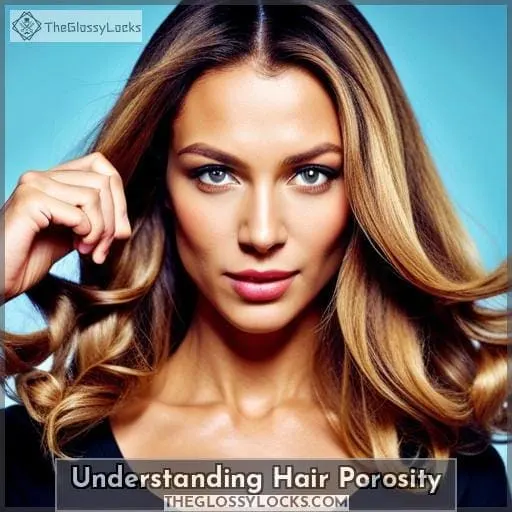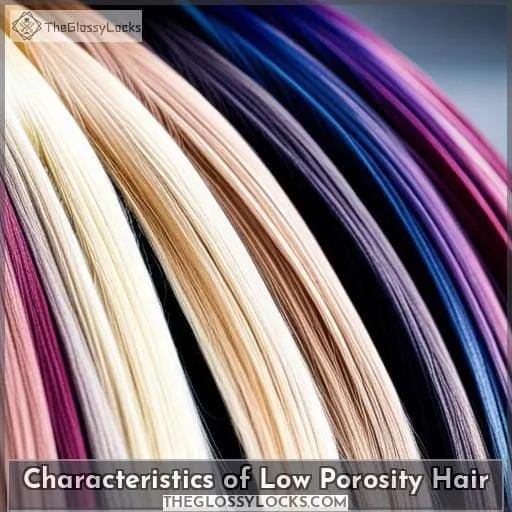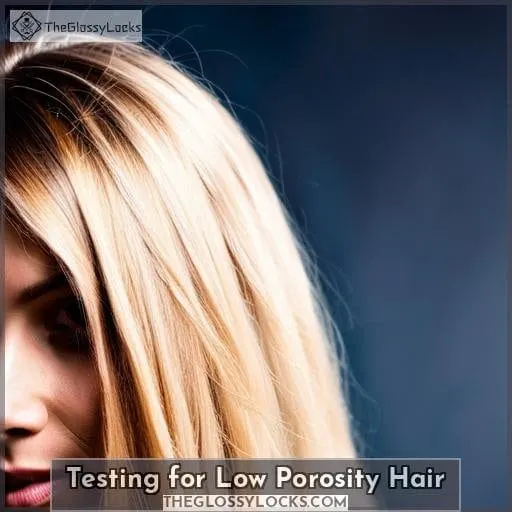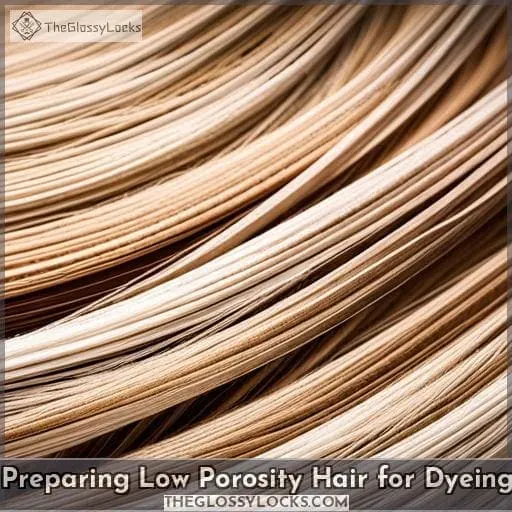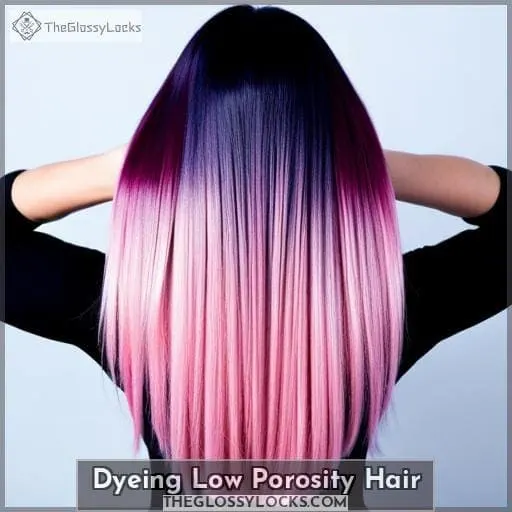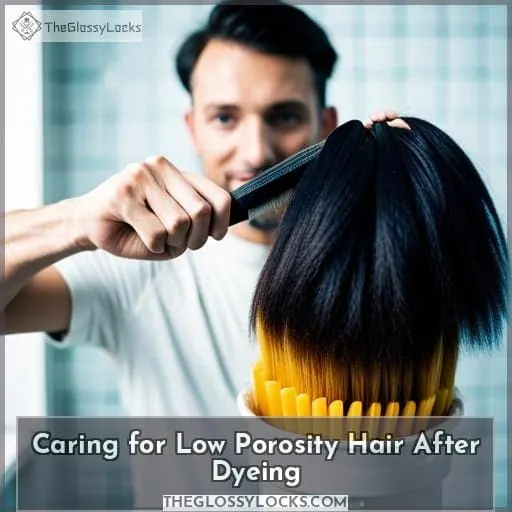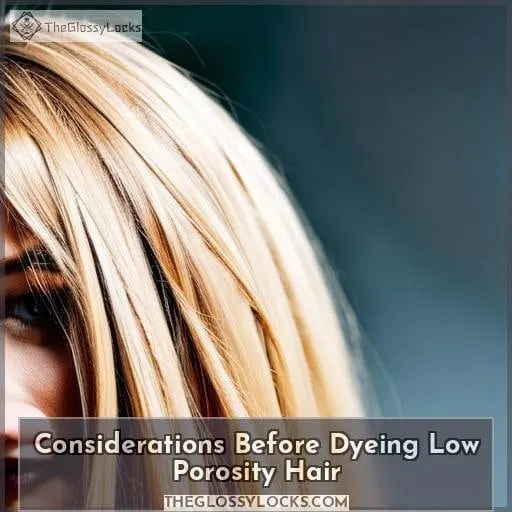This site is supported by our readers. We may earn a commission, at no cost to you, if you purchase through links.
Are you looking to dye your low porosity hair? It can be a tricky process, but with the right preparation and product selection, it is possible for even those with the most challenging locks.
Before getting started on this project, it’s important to understand what exactly low porosity hair is and how best to care for it. Additionally, there are certain considerations that should be taken into account when deciding whether or not dyeing your hair is worth the effort.
This article will discuss all of these topics in detail so you’ll have all of the information necessary before taking action!
Table Of Contents
- Key Takeaways
- Understanding Hair Porosity
- Characteristics of Low Porosity Hair
- Testing for Low Porosity Hair
- Preparing Low Porosity Hair for Dyeing
- Dyeing Low Porosity Hair
- Caring for Low Porosity Hair After Dyeing
- Considerations Before Dyeing Low Porosity Hair
- Frequently Asked Questions (FAQs)
- How long will the dye last on low porosity hair?
- Can I dye my hair at home or is it better to go to a salon?
- Is it possible to reverse the damage caused by dyeing?
- What are the best products to use on low porosity hair before and after dyeing?
- Will the texture of my hair change significantly after dyeing?
- Conclusion
Key Takeaways
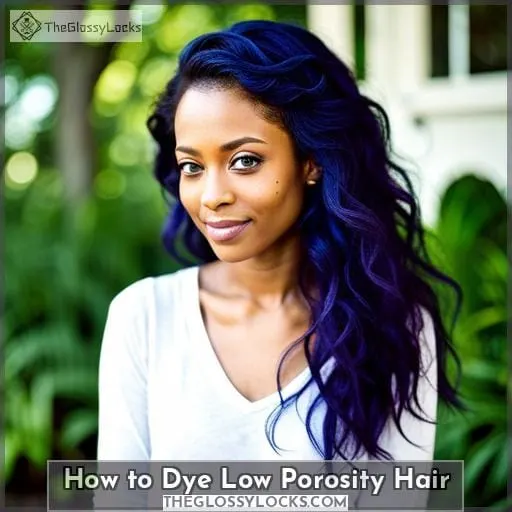
Preparing low porosity hair before dyeing is essential to avoid damage. Tests such as stretch, float, and texture tests can determine hair porosity, and priming and after-color treatments are important for maintaining healthy hair.
- Choosing the right products is crucial for dyeing low porosity hair. Sulfate-free shampoos, ammonia-free formulas, and high-quality oils can help protect and restore hair’s natural texture and porosity.
- The type of color and developer used should be selected based on the desired end result and natural hair color. Demi-permanent colors with low-level 10 developers are recommended for minor changes, while high lift color requires more attention in product selection.
- After-color treatment is important for long-term protection and includes gentle cleansing, pre-treating with protective oils, color retention using protein masks, and regular maintenance products. Consulting professionals can offer tailored advice for dyeing delicate strands
Understanding Hair Porosity
Understanding your hair’s ability to absorb moisture is key when it comes to achieving vibrant color without damaging or over-processing your strands. Hair porosity determines this ability and can be classified into three categories: low, medium, and high.
Low porosity has flattened cuticles, which makes it difficult for products like water and dyes to penetrate the strand. Signs of low porosity include product buildup on the surface of the hair, slower drying times after wash day, as well as oiliness or dryness in between washes depending on how much hydration you give your tresses.
There are several tests you can do at home, such as a stretch test, float test, or texture test, that will help determine if you have low porosity hair. However, consulting with a professional may provide more accurate results based on looking at individual cuticles under magnification and determining their shape/structure using specialized tools like microscopes, etc.
If dyed incorrectly, scarring could occur due to the lack of proper penetration from dye molecules causing pigment loss, as well as improper lifting/opening of each individual cuticle leading to possible additional damage beyond fading color over time.
Priming is done before dyeing by clarifying any product buildup so that there’s nothing blocking access for pigments trying to get inside nor cutting down processing time during application because too much moisturizing oils present in some cases make oxidation harder, thus affecting the final result achieved from desired shade(s) being applied afterward.
Additionally, an after-color treatment should also be used following the coloring session consisting of sulfate-free shampoo specifically formulated for lower porous textures, avoiding hot water temperatures when washing (as heat usually causes further weakening of already weakened bonds within the structure), using quality hair care oils designed for such types, along with regular conditioning sessions every few weeks to keep a healthy hydrated balance required to achieve the most out of the style while helping the longevity and vibrancy of colors obtained throughout the process
Characteristics of Low Porosity Hair
You may notice that your tresses don’t drink up moisture quite as quickly as your friends’ locks, making it seem like a steel fortress against the water droplets. This could be an indication of low levels of hair porosity. Low porosity hair is characterized by its tightly bound cuticles which create a protective layer, but can also make it difficult for product and water to penetrate through the strands.
Here are some tips on how you can dye this type of hair with minimal damage while still achieving vibrant results:
- Heating protection: To ensure that heat from styling tools does not cause excessive damage to already fragile strands, use a thermal protectant spray or cream before blow-drying or using curling irons/flatirons on your hair.
- Clarifying treatments: Before applying any color treatments to low-porosity hair, use clarifying shampoos such as WOW Apple Cider Vinegar shampoo in order to remove buildup so the dye will be able to absorb evenly into each strand without being hindered by excess oils and products sitting on top of them.
- Color Levels & Developer Types: Depending upon desired end result, choose either demi-permanent (lasts longer than temporary dyes but doesn’t open up cuticle) which uses level 10 developer or permanent (opens cuticle) with ammonia color remover. Be sure when choosing colors, take into account both natural color tone and potential for overprocessing due to high porosity trait.
- Hair Oils & Sulfate-free Shampoos: Choose sulfate-free shampoos specifically designed for low-porosity types like WOW Moroccan Argan Oil Shampoo Conditioner in order to keep nourishments locked within each strand while avoiding drying out scalp too much during washing process; incorporate quality high oil serums into regular haircare routine to help maintain a healthy balance between moisture loss prevention proper hydration levels needed to achieve beautiful vibrancy post-treatment period ends.
By taking these precautions prior to coloring processes involving highly porous textures, you’ll have greater peace of mind knowing you won’t need to worry about possible negative effects associated with overprocessing since you took proactive steps to guarantee the best results possible!
Testing for Low Porosity Hair
Testing your hair’s ability to absorb moisture can help you make the best choices for vibrant, long-lasting color. To test for low porosity hair, it is important to look at how quickly your strands lose their shape when stretched or flattened and also take note of whether they float in water or sink.
The stretch test involves gently stretching out a strand of wet hair between two fingers. If the strand stays extended, then you have low porosity hair. Alternatively, the float test requires dropping a small section of clean, dampened hair into a bowl filled with room temperature water.
If it sinks, then this indicates that there may be an issue with absorption rates due to blocked cuticles preventing moisture from entering the shafts easily, as seen in high porosity cases.
To ensure better results before dyeing low porosity locks, moisturizing tips should include pre-color treatments such as deep conditioning prior to applying dyes and avoiding sulfates, which strip away natural oils necessary for retaining color vibrancy over time.
Color choices are often dependent on the desired end result, but consulting professionals who specialize in permanent dyes can offer advice tailored specifically towards achieving great outcomes without damaging delicate strands further, primarily caused by bleaching agents used during double processing techniques on darker hues.
Henna stains are difficult (if not impossible) to remove once applied, while demi-permanent colors require lower level developers than permanent ones, thus reducing potential damage risks associated with coloring fine or fragile textures, even under ideal circumstances where preparations have been made correctly beforehand.
Preparing Low Porosity Hair for Dyeing
Before you take the plunge into a new hair color, it’s important to give your tresses some TLC by clarifying and priming your strands like a pro – prepare for takeoff! To properly dye low porosity hair, you must first understand how its structure affects moisture retention.
Clarifying and priming can help achieve maximum results when dyeing with minimal damage.
Consult with an experienced professional stylist who is knowledgeable about selecting the right product for your unique needs.
Use a positive conditioning treatment before coloring; this will strengthen weak areas of the strand while aiding in moisture retention which helps reduce breakage during processing time.
Choose a color preserving shampoo that has no sulfates or parabens; this will prevent stripping away natural oils while allowing cuticles to rest between washings so that pigment stays put longer without causing dryness or damage from harsh ingredients found in conventional shampoos/conditioners.
Make sure all styling tools used during the preparation process have been properly sanitized before use (i.e., flat iron). Heat can increase already existing stressors caused by environmental factors making them more susceptible to further harm if precautions aren’t taken beforehand.
Test out different colors on small swatches prior to committing to full head application; this allows one to get familiarized with desired shade selection ahead of time, ensuring there won’t be any surprises once the final application takes place later down the line.
Now armed with all the necessary information, you’re ready to begin your journey exploring the world of vibrant hues!
Dyeing Low Porosity Hair
So you’ve done the hard part – prepping your low porosity hair for dyeing. Now it’s time to apply color and developer to achieve that perfect hue! When applying permanent or semi-permanent color, make sure to use enough product so that all of your strands are evenly saturated.
Afterwards, give yourself an after-color treatment by using a deep conditioning mask specifically designed for dyed hair. This will help seal in moisture and keep pigments from fading quickly over time.
Applying Color and Developer
Now that your hair is prepped, it’s time to apply the color and developer to achieve the desired result. When dyeing low porosity hair, make sure you are protecting its delicate texture by using a sulfate-free shampoo and an ammonia-free formula.
Depending on what type of change in color you want (minor or major), determine if permanent dye needs to be used as well as pre-dye treatment for long-term care. For minor changes, use demi-permanent colors with low-level 10 developers. They will last longer without overly damaging cuticles while giving vibrant results without lifting natural hue too much.
If going lighter is desired, then high lift color may need more attention when selecting products since stronger developer levels can cause irreparable damage, making recovery difficult or impossible in some cases.
In any case, always remember that even though this process can be exciting, there are potential risks involved.
After-Color Treatment
Once you’re finished applying the color and developer, it’s time to treat your hair with an after-color treatment for long-term protection.
- Gentle cleansing with sulfate-free shampoo to prevent irritation.
- Pre-treating with protective oils like WOW Moroccan Argan Oil Shampoo and Conditioner.
- Color retention using protein masks or pre-color treatments formulated specifically for colored hair.
- Regular maintenance products such as WOW Apple Cider Vinegar Shampoo, which is packed full of natural ingredients that help restore your natural hair color while preserving strength and shine!
The power of pure Moroccan argan oil not only nourishes dry strands but also guards against fading, so this type of care should be part of any dyeing regimen if beautiful results are desired in a healthy way!
Caring for Low Porosity Hair After Dyeing
Congratulations! You’ve successfully dyed your low porosity hair and are ready to enjoy the vibrant results. To keep that color looking fresh, it’s important to know how best to care for your newly-dyed locks.
Start with a sulfate-free shampoo and regular conditioning. These products won’t strip away moisture or fade pigments, helping you maintain great color longer. WOW Moroccan Argan Oil Shampoo and Conditioner are perfect for low porosity hair, as well as WOW Apple Cider Vinegar shampoo if you need an occasional clarifying wash.
With these tips in mind, you’ll be able to show off beautiful tresses every day!
Sulfate-Free Shampoo and Regular Conditioning
To keep your newly dyed hair looking vibrant and healthy, use a sulfate-free shampoo and regular conditioning to lock in moisture.
Before dyeing low porosity hair, it is important to consider the chemical process involved as well as how heat styling can affect color intensity. An ammonia-free product or one with very low levels of ammonia should be used for permanent dyes, while a demi-permanent color can also be utilized with level 10 developer for longer-lasting results without damage.
A deep conditioner after coloring will help close the outer layer of the hair shaft so that natural oils don’t escape too quickly, which leads to dryness and breakage over time. Regular conditioning treatments will help maintain moisture retention following any kind of chemical process on your strands, giving them additional protection from fading or becoming brittle due to environmental factors such as sun exposure and pollution.
Keep up these simple yet effective techniques after dyeing low porosity locks for optimal health!
Best Products for Low Porosity Hair
For the best results, try using a high-quality sulfate-free shampoo and conditioner designed specifically for your freshly dyed hair type! Hair porosity plays an important role in the success of color treatments because it determines how well products can penetrate into each strand.
Low porosity locks have flattened cuticles, which make it difficult for water or other products to pass through. To prime long hair before dyeing, use a clarifying shampoo such as WOW Apple Cider Vinegar Shampoo that is specially formulated to open up strands so they are more receptive to color developers.
If you do not plan on permanently dyeing your low porosity tresses, opt for temporary dyes instead since these require less processing, and no ammonia or bleach formulas are used during application. For permanent coloring sessions, be sure to select an ammonia-free product with low levels of developer like Ion Demi Permanent Light Burgundy Blonde.
This will ensure maximum vibrancy without damaging delicate strands over time due to excessive chemicals involved in double processes on dark hair types.
After dyeing any kind of tresses, add some extra protection by using a moisturizing oil like WOW Moroccan Argan Oil Shampoo & Conditioner.
Considerations Before Dyeing Low Porosity Hair
Before altering your hair color, it’s important to assess the texture and moisture absorption abilities of your locks in order to prevent any irreversible damage. Low porosity hair can be especially difficult when dyeing as it is often resistant to absorbing products and water due to its flattened cuticles.
To properly care for low porosity hair before dyeing, consider consulting a professional who may provide helpful advice on selecting the right color based on factors like natural hair hue, desired outcome, or even potential level of developer needed.
Additionally, they will also help determine if you should opt for a temporary or demi-permanent dye depending on how much openness outside of the shaft is ideal given your unique circumstances.
Cleansing prior to using sulfate-free shampoo specifically designed for low porosity tresses helps ensure maximum product penetration by removing buildup that could affect results. Primers such as WOW Apple Cider Vinegar Shampoo add an extra layer of protection against over-processing with its clarifying properties, which help open up strands more evenly during the application process without harsh chemicals found in regular dyes causing excessive dryness afterwards leading into other problems down the line eventually damaging them further than what was originally intended.
Overall, assessing proper preparation techniques beforehand are essential key players when considering taking part in this type of activity since there’s no telling what kind of obstacles one might experience along the way from start until the end result, particularly with certain types of textures.
Frequently Asked Questions (FAQs)
How long will the dye last on low porosity hair?
The longevity of dye on low porosity hair varies, but it often lasts longer than other types.
Can I dye my hair at home or is it better to go to a salon?
Dyeing your hair can be a tricky business. To get the best results, it’s wise to go to an experienced stylist.
Is it possible to reverse the damage caused by dyeing?
Yes, it is possible to reverse the damage caused by dyeing. Regular use of sulfate-free shampoo and high-quality hair oils can help restore your hair’s natural texture and porosity.
What are the best products to use on low porosity hair before and after dyeing?
For low porosity hair, it is best to use sulfate-free shampoo, high-quality oils, and conditioner.
Will the texture of my hair change significantly after dyeing?
Yes, the texture of your hair can change significantly after dyeing. Bleach and permanent dyes open up the cuticles, which can lead to increased porosity and damage. Demi-permanent colors are less harsh but still alter the curl pattern and elasticity.
Conclusion
Your low porosity hair can be dyed if you take the right steps and use the right products. It’s important to prime your hair with a clarifying shampoo and pre-color treatment for best results. Then, use a low-level developer for your dye. After-color treatment and high-quality hair oils are also recommended to help keep your hair healthy and prevent damage.
The effects of dyeing your low porosity hair can ripple through your hair health, just as a single drop of water can ripple through a pond.

